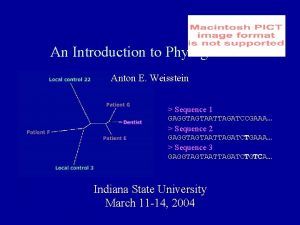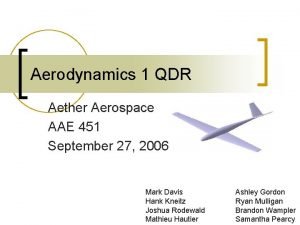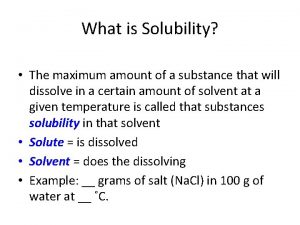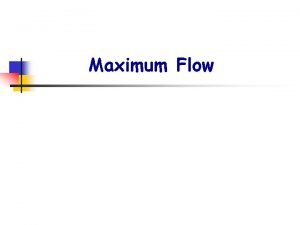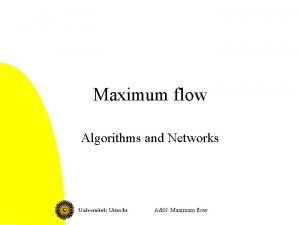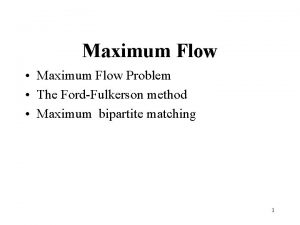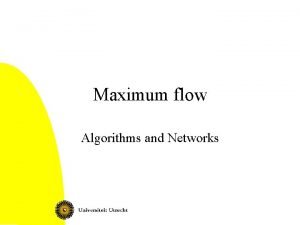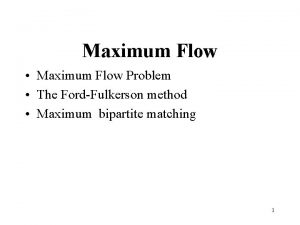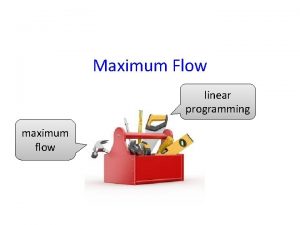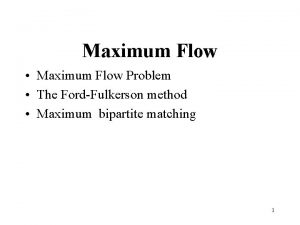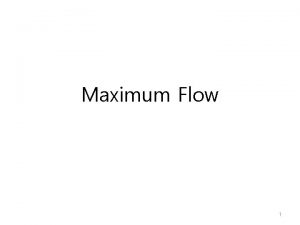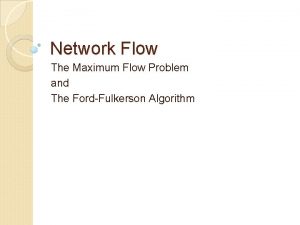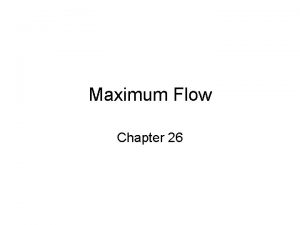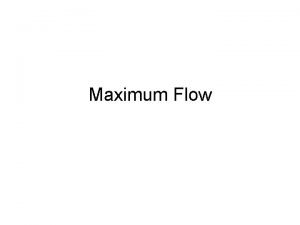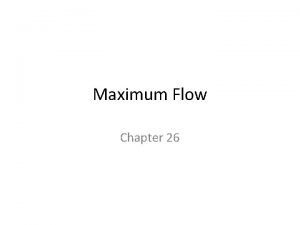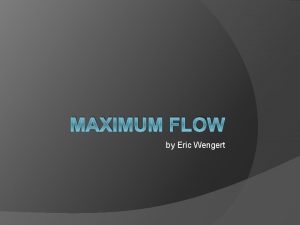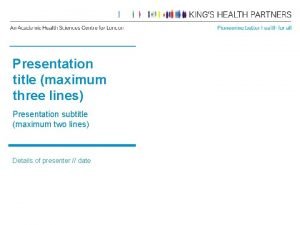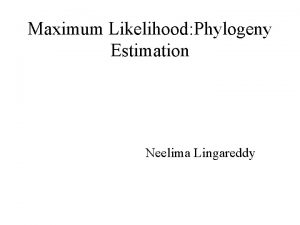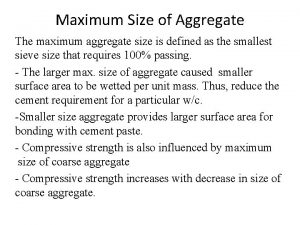Maximum Flow c v 46 11 33 s





















- Slides: 21

Maximum Flow c v 4/6 1/1 3/3 s 3/5 Maximum Flow w 1/1 u 9/29/2020 6: 44 PM 3/3 2/2 t 4/7 1/9 3/5 z 1

Outline and Reading Flow networks n n Flow (§ 8. 1. 1) Cut (§ 8. 1. 2) Maximum flow n n Augmenting path (§ 8. 2. 1) Maximum flow and minimum cut (§ 8. 2. 1) Ford-Fulkerson’s algorithm (§ 8. 2. 2 -8. 2. 3) Edmonds-Karp algorithm (§ 8. 2. 4) Maximum Bipartite Matching Minimum Cost Flow (§ 8. 4) 9/29/2020 6: 44 PM Maximum Flow 2

Flow Network A flow network (or just network) N consists of n n A weighted digraph G with nonnegative integer edge weights, where the weight of an edge e is called the capacity c(e) of e Two distinguished vertices, s and t of G, called the source and sink, respectively, such that s has no incoming edges and t has no outgoing edges. Example: v 6 1 w 1 5 u Maximum Flow t 7 3 s 9/29/2020 6: 44 PM 3 2 9 5 z 3

Flow A flow f for a network N is an assignment of an integer value f(e) to each edge e that satisfies the following properties: Capacity Rule: For each edge e, 0 f (e) c(e) Conservation Rule: For each vertex v s, t where E-(v) and E+(v) are the incoming and outgoing edges of v, resp. The value of a flow f , denoted |f|, is the total flow from the source, which is the same as the total flow into the sink Example: v 1/3 2/6 1/1 3/3 s 1/1 3/5 u 9/29/2020 6: 44 PM w Maximum Flow 2/2 t 3/7 2/9 4/5 z 4

Maximum Flow A flow for a network N is said to be maximum if its value is the largest of all flows for N The maximum flow problem consists of finding a maximum flow for a given network N Applications n n Hydraulic systems Electrical circuits Traffic movements Freight transportation 9/29/2020 6: 44 PM v 2/6 1/1 3/3 s 1/3 w 1/1 3/5 3/7 2/9 t 4/5 z 2/2 Flow of value 8 = 2 + 3 = 1 + 3 + 4 u v 4/6 1/1 3/3 s 3/3 1/1 3/5 w 3/7 2/9 t 4/5 z 2/2 Maximum flow of value 10 = 4 + 3 = 3 + 4 Maximum Flow u 5

Cut c A cut of a network N with source s and sink t is a partition c = (Vs, Vt) of the vertices of N such that s Vs and t Vt Forward edge of cut c: 6 9/29/2020 6: 44 PM Maximum Flow 3 1 s w 1 5 u t 7 3 origin in Vs and destination in Vt Backward edge of cut c: origin in Vt and destination in Vs Flow f(c) across a cut c: total flow of forward edges minus total flow of backward edges Capacity c(c) of a cut c: total capacity of forward edges Example: c(c) = 24 f(c) = 8 v 9 5 z 2 c v 2/6 1/1 3/3 s 1/3 w 1/1 3/5 u 2/2 t 3/7 2/9 4/5 z f(c) = 2 – 1 + 3 + 2 = 8 6

Flow and Cut Lemma: The flow f(c) across any cut c is equal to the flow value |f| Lemma: The flow f(c) across a cut c is less than or equal to the capacity c(c) of the cut Theorem: The value of any flow is less than or equal to the capacity of any cut, i. e. , for any flow f and any cut c, we have |f| c(c) 9/29/2020 6: 45 PM Maximum Flow c 1 c 2 v 2/6 1/1 3/3 s 3/5 1/3 w 1/1 u 2/2 t 3/7 2/9 4/5 z |f| = 8 c(c 1) = 6 + 3 + 1 + 2 = 12 c(c 2) = 3 + 7 + 9 + 2 = 21 7

Augmenting Path Consider a flow f for a network N Let e be an edge from u to v: n Residual capacity of forward edge e, from u to v: Df(u, v) = c(e) - f (e) Residual capacity of backward edge e, from v to u: Df(v, u) = f (e) Let p be a path from s to t n The residual capacity Df(p) of p is the smallest of the residual capacities of the edges of p A path p from s to t is an augmenting path if Df(p) > 0 p v 2/6 1/1 3/3 s 2/5 1/3 w 0/1 u t 2/7 2/9 2/2 4/5 z Df(s, u) = 3 Df(u, w) = 1 Df(w, v) = 1 Df(v, t) = 2 Df(p) = 1 |f| = 7 9/29/2020 6: 45 PM Maximum Flow 8

Flow Augmentation Lemma: Let p be an augmenting path for flow f in network N. There exists a flow f for N of value | f | = |f | + Df(p) Proof: We compute flow f by modifying the flow on the edges of p n n Forward edge: f (e) = f(e) + Df(p) Backward edge: f (e) = f(e) - Df(p) v 2/6 3/3 s 2/5 Maximum Flow 1/3 1/1 w 0/1 u t 2/7 2/9 4/5 z 2/2 |f|=7 Df(p) = 1 v 2/6 3/3 s 3/5 p 2/3 0/1 w 1/1 u 9/29/2020 6: 45 PM p 2/2 t 2/7 2/9 4/5 z | f | = 8 9

Ford-Fulkerson’s Algorithm Initially, f(e) = 0 for each edge e Repeatedly n n Search for an augmenting path p Augment by Df(p) the flow along the edges of p A specialization of DFS (or BFS) searches for an augmenting path An edge e is traversed from u to v provided Df(u, v) > 0 9/29/2020 6: 45 PM Algorithm Ford. Fulkerson. Max. Flow(N) for all e G. edges() set. Flow(e, 0) while G has an augmenting path p { compute residual capacity D of p } D for all edges e p { compute residual capacity d of e } if e is a forward edge of p d get. Capacity(e) - get. Flow(e) else { e is a backward edge } d get. Flow(e) if d < D D d { augment flow along p } for all edges e p if e is a forward edge of p set. Flow(e, get. Flow(e) + D) else { e is a backward edge } set. Flow(e, get. Flow(e) - D) Maximum Flow 10

Max-Flow and Min-Cut Termination of Ford-Fulkerson’s algorithm n Theorem: The value of a maximum flow is equal to the capacity of a minimum cut There is no augmenting path from s to t with respect to the current flow f c Define Vs set of vertices reachable from s by augmenting paths Vt set of remaining vertices Cut c = (Vs, Vt) has capacity c(c) = |f| n Forward edge: f(e) = c(e) Backward edge: f(e) = 0 Thus, flow f has maximum value and cut c has minimum capacity 9/29/2020 6: 45 PM Maximum Flow v 4/6 1/1 3/3 s 3/5 3/3 w 1/1 u t 4/7 1/9 2/2 3/5 z c(c) = | f | = 10 11

Example (1) v 0/6 0/1 0/3 s u w 0/1 u 9/29/2020 6: 45 PM 0/5 1/5 z u 1/2 t v 0/9 1/5 z Maximum Flow 1/5 0/9 1/5 z 1/3 0/1 w 0/1 u t 2/7 1/2 2/3 s w 0/1 1/6 1/7 0/3 1/1 1/3 s 0/3 0/1 1/3 t 0/9 0/2 v 0/6 1/5 w v 1/6 1/7 1/1 1/5 s 0/3 1/2 t 2/7 0/9 1/5 z 12

Example (2) v 3/6 0/1 2/3 s 1/5 3/3 w 0/1 u 4/6 t 2/7 0/9 1/5 3/3 1/1 3/3 s z 1/2 v w 0/1 u t 3/7 1/9 2/5 z 1/2 two steps v 3/6 0/1 3/3 s 1/5 3/3 w 0/1 u 9/29/2020 6: 45 PM 1/2 v 4/6 t 2/7 1/9 2/5 z Maximum Flow 1/1 3/3 s 3/5 3/3 w 1/1 u 2/2 t 4/7 1/9 3/5 z 13

Analysis In the worst case, Ford. Fulkerson’s algorithm performs |f*| flow augmentations, where f* is a maximum flow Example n n s 1/1 1/50 The augmenting paths found alternate between p 1 and p 2 The algorithm performs 100 augmentations Finding an augmenting path and augmenting the flow takes O(n + m) time The running time of Ford. Fulkerson’s algorithm is O(|f*|(n + m)) 9/29/2020 6: 45 PM Maximum Flow v 0/50 1/50 0/50 v 0/1 u t p 1 u 1/50 s 1/50 t p 2 1/50 14

Edmonds-Karp Algorithm Variation of Ford-Fulkerson’s algorithm Uses a simple technique for finding good augmenting path in faster running time. n n n It is more greedy in the choice of path Chooses an augmenting path p with the smallest number of edges This can be done in O(m) by a modified BFS traversal Complexity O(n m 2) Lemma: The number of flow augmentations in the Edmonds-Karp algorithm for a network with n vertices and m edges is no more than n m. 9/29/2020 6: 45 PM Maximum Flow 15

Maximum Bipartite Matching Graph G(V, E) is bipartite (denoted G(V 1, V 2, E) ) if n The vertices V of G can be partitioned into two disjoint sets, V 1 and V 2 Every edge e of G has one endpoint in V 1 and the other in V 2. A matching in G is a set of edges (subset of E) that have no endpoints in common. A matching in bipartite graph is called bipartite matching. We are often interested in maximum matching, that is, the matching with maximum number of edges. M=1 M=2 V 1 9/29/2020 6: 45 PM Maximum Flow V 2 16

Maximum Bipartite Matching Solution is non-unique Examples: (all are maximum, M=2) 9/29/2020 6: 46 PM Maximum Flow V 1 V 2 17

Reduction to Max Flow Problem Systematic approach to bipartite matching problem Create a network flow N from graph G(V 1, V 2, E): n n Add a source s and a sink t Connect s with. V 1 and t with V 2, using directed edges Direct edges E from V 1 to V 2 and assign capacities c(e)=1 Solve a max flow problem on the network flow N max M = max f V 1 t s 9/29/2020 6: 46 PM V 2 Maximum Flow 18

Reduction to Max Flow Problem Proof of correctness n n n f(e) = 1 e M Set M is a matching: w The flow through e is 0 or 1 (capacity is 1) w Each vertex in V 1 has exactly one incoming edge: by flow conservation rule there is at most one outgoing edge for v V 1 Each vertex in V 2 has exactly one outgoing edge: there is at most one incoming edge for v V 2 Hence, each vertex in V 1 will be paired in M by at most one vertex in V 2. , hence M is the matching. Finally, size of M = |f|. V 1 t s 9/29/2020 6: 46 PM V 2 Maximum Flow 19

Minimum Cost Flow Problem A variant of the max flow problem, applicable to networks where there is a cost w(e) associated with sending a unit flow through an edge. n Associate cost w(e) with each edge e in the network N n Compute flow f with minimum total cost: min w(f) = e E w(e) f(e) n That is, find a minimum-cost flow among all the flows of maximum value f n Sometimes, given a fixed flow f, compute minimum-cost flow with flow value = f. Solving min-cost flow uses augmented cycles concept. 9/29/2020 6: 46 PM Maximum Flow 20

Minimum Cost Flow Problem f(e) / c(e), w(e) Augmenting cycle : a cycle that has non-zero residual capacity Df( ) Residual capacity Df( ) along the cycle : min of u 1 / 1, 3 s c(e)-f(e) forward edges f(e)>0 for backward edges 1 / 2, 1 0 / 3, 1 1 / 2, 1 t 1 / 1, 3 v Example: Initially f=2 and w(f)=8 Augmenting cycle {s, v, u, s} has residual capacity Df( ) = 1. The cost of is w( )=-1 Flow f’ obtained by pushing 1 unit of flow along has cost: w(f’) = w(f) + w( ) Df( ) = 8 - 1= 7 9/29/2020 6: 46 PM Maximum Flow u 0 / 1, 3 s 1/3, 1 2 / 2, 1 v 1 / 2, 1 t p 2 1/ 1, 3 21
 Maximum likelihood vs maximum parsimony
Maximum likelihood vs maximum parsimony Maximum likelihood vs maximum parsimony
Maximum likelihood vs maximum parsimony Local max
Local max Baseball elimination problem maximum flow
Baseball elimination problem maximum flow Dfd to structure chart
Dfd to structure chart High flow versus low flow oxygen
High flow versus low flow oxygen Cheese making flow chart
Cheese making flow chart Internal vs external flow
Internal vs external flow Data flow structure
Data flow structure Trach collar oxygen flow rates
Trach collar oxygen flow rates Control flow and data flow computers
Control flow and data flow computers Flow energy review
Flow energy review Rotational and irrotational flow difference
Rotational and irrotational flow difference Non rebreather mask definition
Non rebreather mask definition Control flow vs transaction flow
Control flow vs transaction flow Oikos meaning
Oikos meaning Data flow vs control flow
Data flow vs control flow Internal and external flow
Internal and external flow Turbulent flow vs laminar flow
Turbulent flow vs laminar flow Aether aeronautics
Aether aeronautics Optimization problems maximum and minimum
Optimization problems maximum and minimum Solubility is the maximum amount of
Solubility is the maximum amount of

